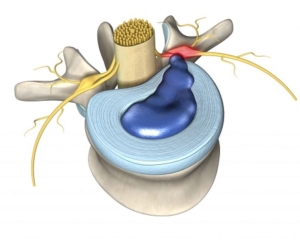Annular Tear Symptoms & Treatment Options
Annular tear refers to an abrupt disruption of the fibers around a spinal disc or spinal cartilage. These can ofter occur spontaneously with daily activities as well as after trauma or injury. Regardless or the cause, when you experience pain located to a specific area of the spine ( neck or low back) and have radiation symptoms like shooting pain to the arms in the case of neck tear or shooting pain to the legs in case of lumbar or low back tear, you might overtime feel improvement. Nevertheless sometimes your doctor might need to assist with the healing process.
Types of Annular Tears
It seems that annular tears would occur in a fairly straightforward way. The disc itself becomes weak and/or a force causes the disc to rip. And, while this may be true, annular tears can actually occur in 3 different patterns. (Although you might be asking… Who cares if an annular tear is radial vs. concentric? How the disc tears actually reveals quite a bit about the symptoms that will emerge).
The 3 major types of disc tears include:
Transverse Tears: Transverse tears begin in the outermost rim of the disc and can extend all the way to the nucleus. This is significant because the outer ? of the disc is highly innervated with pain receptors. If you experience an annular tear here, it’s fairly difficult not to notice.
Radial Tears: These tears begin at the innermost portion of the annulus and can continue to crack until they reach the rim. Because these tears begin in the center of the disc where pain receptors are sparse, they do not always cause symptoms.
Concentric Tears: Concentric tears develop in a ring that encircles the nucleus of the disc. They are often the result of torsional injuries, or twisting the wrong way. (Think of throwing out your back while swinging a golf club.)
Symptoms of an Annular Tear
Annular tears can have symptoms that are very similar to bulging or herniated discs. However, disc tears do not usually produce symptoms unless the outer of the disc is damaged or a spinal nerve becomes pinched.
Sound like you? Contact our office for immediate pain relief!
Causes of an Annular Tear
Annular tears often result from gradual wear and tear or sudden, traumatic injury. The factors leading to an annular tear are usually as follows:
Degenerative Disc Disease (DDD): DDD occurs when the spinal discs begin to break down, or degenerate, from excess wear and tear. Often this coincides with a loss of fluid inside the disc, a normal facet of the aging process. As the disc begins to dry out, it also loses some of its flexible nature. This ultimately makes the disc more prone to tearing.
Traumatic Injuries: Sports collisions, car accidents, and falls… Each of these events can cause instantaneous damage to a spinal disc.
Overuse: Repetitive, heavy lifting and occupations that place chronic strain on the back (like sports, nursing, or construction) can lead to annular tears.
Genetics: Your genes often determine the strength and quality of your collagen, the substance that makes up the annulus. Poor cartilage production or inferior collagen can make annular tears more likely.
Worried that you might have an annular tear? Contact our disc experts! Dr. Martin specializes in annular tears, bulging discs, and disc herniations. For superior spine care that you count on, contact us today!
How an Annular Tear is Diagnosed
 If you suspect that you might have a torn disc, then your doctor will need to perform imaging tests to confirm the presence of the tear. In particular, your doctor will need to order an MRI or CT scan with spinal die if you can not undergo MRI, to reveal soft tissues, like spinal discs and nerve compression. Your doctor should also perform a physical examination, which involves palpating (or touching) the spine and investigating any painful areas. Once you have received your diagnosis, your doctor will prescribe a regimen of pain relief options.
If you suspect that you might have a torn disc, then your doctor will need to perform imaging tests to confirm the presence of the tear. In particular, your doctor will need to order an MRI or CT scan with spinal die if you can not undergo MRI, to reveal soft tissues, like spinal discs and nerve compression. Your doctor should also perform a physical examination, which involves palpating (or touching) the spine and investigating any painful areas. Once you have received your diagnosis, your doctor will prescribe a regimen of pain relief options.
Looking for a doctor who can diagnose disc pain? Seek the advice of a board-certified spine surgeon Dr. Martin has over a decade of experience in resolving annular tears, bulging discs, and disc herniations!
If You Or Someone You Know Is Experiencing AS, The Following Symptoms May Emerge:
- Annular tears cause localized or “discogenic” pain
- Radiating pain may also travel into the arms, legs, hands, or feet
- Muscle weakness can occur if lumbar or cervical nerves become pinched
- The limbs may also tingle or become numb
- Pain is often worse while sitting, bending, lifting, or twisting or any activity.
More about Dr. Matin
Annular Tear Treatment Options
Annular tear can be treated by Dr. Martin, give us a call to schedule an appointment.
We will provide different options of treatment.
Pain Medications
Often, annular tears will heal on their own when given sufficient time. In the meantime, your doctor may prescribe pain medications, NSAID’s or stronger prescription medications and steroids.
Physical Therapy
Exercise is often one of the most prescribed methods for relieving a torn disc. By working with a physical therapist, you can develop a routine of stretches and weight-bearing exercises that maintain flexibility while enhancing strength.
Microdiscectomy
If your torn disc does not heal after medication and conservative therapy, your doctor may recommend minimally invasive spine surgery. During a microdiscectomy, your doctor will remove and repair damaged portions of your disc. Endoscopic minimally invasive is an emerging option that facilitates healing and shortens recovery.
Artificial Disc Replacement
If your disc becomes too unstable for microdiscectomy, your surgeon many suggest an artificial disc replacement. During this procedure, the damaged disc is removed and replaced with a device that resembles or mimics normal or “near physiologic” cartilage function.





